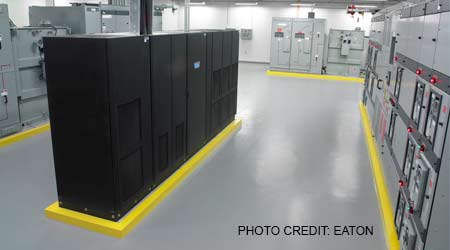Understanding UPS Offline Design Trend, Redundancy Options
Part 1 of a 4-part article describing UPS technology and configuration trends that FMs should consider before selecting a system
Uninterruptible Power Supply (UPS) systems are evolving at a pace nearly as rapid as cars, mobile phones, and TV sets. As time goes on, facility managers continue to get more bang for the buck with new equipment. UPS equipment is improving, from small to large systems, with better reliability, lower cost, more capacity with the same or smaller size, much improved local and remote monitoring, and new redundant configuration options. To guide your decision, here is a look at 10 key UPS trends, beginning, in this part, with a look at offline UPS designs and redundancy options.
THE OFFLINE/ONLINE CONUNDRUM HAS COME FULL CIRCLE.
Once upon a time, as recently as maybe seven or eight years ago, offline UPS designs were the scourge of the industry. Those in the know could never get comfortable with a UPS that needed to wake up and kick into gear instantly and reliably when power failed. The image of the light bulb that works fine when it is left on and warm but burns out when it has been off and cool then is switched on is indelibly burned into the minds of many in the industry.
But today the industry has a generation of experience where many small, inexpensive offline UPS units have proven to be effective. Offline UPS units generally work as designed as long as proactive battery replacement is performed. The vast majority of IT equipment can tolerate the short (less than 12 millisecond) voltage dip while an offline UPS turns on. Now, with a focus in recent years on improving data center energy efficiency, large new fully online UPS systems can be and are increasingly operated in offline or near offline (eco) modes. Operating modern online UPS systems in full eco-mode (essentially offline and asleep), especially at light load (very common with redundant configurations) improves efficiency from as low as 85 percent to as high as 99 percent.
UPS REDUNDANCY OPTIONS ABOUND.
A single UPS unit, with no internally redundant components beyond automatic bypass, is known as N, or non-redundant. Traditionally the only way to improve UPS reliability was with a multi-module system configured as N+1, N+2, etc., typically involving separate, discreet boxes of equipment, field-cabled together, and the addition of redundant battery strings. Then, with the advent of dual-corded IT equipment with redundant power supplies, 2N — or 100 percent redundant dual-bus configurations — became the norm for the highest UPS reliability requirements.
However, 2N configurations require more components with more initial and ongoing maintenance costs. 2N configurations require stranding more than half of installed capacity for potential failovers, and with fully online equipment this results in all equipment operating continuously at low load where its energy efficiency is lower. N+1 systems almost always require components, including future add-on modules, to be from the same vendor and of the same make/model/capacity/vintage. 2N configurations, by contrast, allow for mixing and matching. This allows for configuring a new UPS system while retaining an old system for backup and allows for competitive purchasing of add-on equipment.
However, 2N configurations require more components with more initial and ongoing maintenance costs. 2N configurations require stranding more than half of installed capacity for potential failovers, and with fully online equipment this results in all equipment operating continuously at low load where its energy efficiency is lower. N+1 systems almost always require components, including future add-on modules, to be from the same vendor and of the same make/model/capacity/vintage. 2N configurations, by contrast, allow for mixing and matching. This allows for configuring a new UPS system while retaining an old system for backup and allows for competitive purchasing of add-on equipment.
Related Topics:















